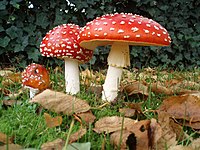Amanita muscaria, commonly known as the fly agaric or fly Amanita, is a poisonous and psychoactive basidiomycete fungus, one of many in the genus Amanita. Native throughout the temperate and boreal regions of the Northern Hemisphere, Amanita muscaria has been unintentionally introduced to many countries in the Southern Hemisphere, generally as a symbiont with pine plantations, and is now a true cosmopolitan species. It associates with various deciduous and coniferous trees. The quintessential toadstool, it is a large white-gilled, white-spotted, usually deep red mushroom, one of the most recognizable and widely encountered in popular culture. Several subspecies, with differing cap colour have been recognised to date, including the brown regalis (considered a separate species), the yellow-orange flavivolata, guessowii, and formosa, and the pinkish persicina. Genetic studies published in 2006 and 2008 show several sharply delineated clades which may represent separate species.
Although generally considered poisonous, it has been consumed as a food in parts of Europe, Asia, and North America after parboiling in plentiful water. However, Amanita muscaria is now primarily famed for its hallucinogenic properties with its main psychoactive constituent being the compound muscimol. It was used as an intoxicant and entheogen by the peoples of Siberia and has a religious significance in these cultures. There has been much speculation on traditional use of this mushroom as an intoxicant existed beyond Siberia, however, such traditions are far less well-documented. The American banker and amateur ethnomycologist R. Gordon Wasson proposed the fly agaric was in fact the Soma talked about in the ancient Rig Veda texts of India; although this theory has been refuted by anthropologists, it gained common credence when first published in 1968.
The common name in English is thought to have been derived from its European use as an insecticide, when sprinkled in milk. The fly-killing agent is now known to be ibotenic acid. An alternative derivation proposes that the term fly- refers not to insects as such but rather the delirium resulting from consumption of the fungus. This is based on the medieval belief that flies could enter a person's head and cause mental illness.
